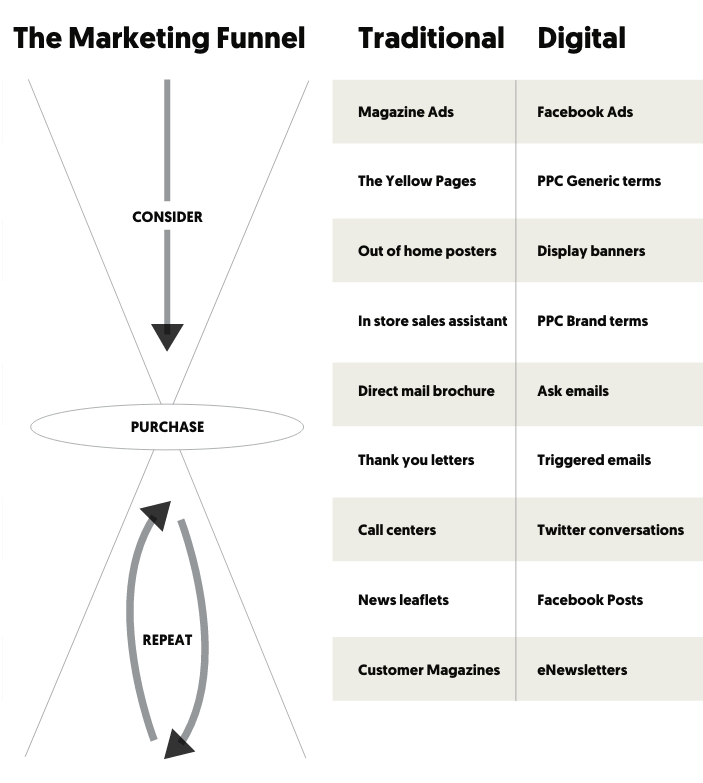Direct and digital marketing, Marketing & communications, Campaigns
Digital advertising models explained through the medium of music flyers
Author of The Complete Fundraising Handbook, James Gadsby Peet, explains digital advertising models using an offline metaphor.
It’s tempting to imagine that all of the digital channels which we know and love are completely new. The narrative around modern marketing is that new opportunities are being created by the minute in Silicon Valley and if you’re not up to speed you’re going to be left behind in a sobbing pile of your own ineptitude.
In my experience though, there’s an awful lot to be learned by looking at the past when considering more up to date channels and techniques. Most digital channels have an equivalent from the ‘offline’ world:
So what if we used a traditional street flyer metaphor to try and explain some of the key concepts of digital marketing? Here’s what I came up with:
Digital buying models
Many digital channels offer a variety of buying models for how you pay a publisher for the adverts which they display.
CPM
The CPM buying model — or Cost per thousand (the M stands for Milli). This is most like the offline world and simply means that you pay a fixed price for showing your advert 1,000 times. Each time an ad is displayed is often called an impression.
It’s like paying a person £5 to stand on a street corner and hand out 1,000 leaflets. The benefits are that you know how much you’ll spend and you know how many times your leaflet will be seen. The disadvantage is that you don’t know exactly who your leaflets will be given to, other than the choice of the street corner and you have to pay the same amount regardless of whether anyone actually takes up the action you’re promoting.
CPC
The CPC buying model stands for Cost per Click. In this arrangement, you only pay a fee whenever someone actually clicks on your advert. At the start of each campaign you would say how much you have to spend overall, so that you don’t go over your budget.
This is like handing a leaflet to people asking them to find out more. You would be watching from your office block and if someone takes out their mobile phone and looks up your website, then you pay the person handing out leaflets £15.
This means that the person handing out leaflets is going to be incentivised to find the most relevant people for your call to action because that’s when they get paid. If they don’t find them, then you don’t pay them anything. The disadvantage is that you may only be engaging with people who already know a bit about you and your organisation, so you may not be growing overall awareness in quite the same way.
Conversion Tracking
If you want to become even more detailed in how you decide where to spend your money, then you can implement conversion tracking on your website and buy adverts based on a Cost per Acquisition/Action. This allows you and the advertising networks you work with (like Facebook or Google), to see if a user actually converts into something like a donor, event participant or forum user. These are small pieces of code that sit on your website and let the advertiser know when one of their users ‘converts.’
To take our flyer distributor metaphor too far — this is like each flyer having a small webcam attached to it, so that we can see when a user opens up their mobile phone and carries on exploring our website. Through that webcam we and our flyer distributor can actually see if the user completes the journey and takes the action we’re hoping to generate. You then pay the distributor £25 and they carry on searching for more people that look like the person who converted.
Re-targeting
One of the other benefits that digital advertising allows us, is to speak to our audiences in multiple places, knowing what information of ours that they’ve seen before. This so called ‘re-targeting’ can take place based on them visiting our website, or the adverts that they have engaged with.
If we think of the world of flyers, it’s the same as us having a network of leaflet distributors on multiple street corners around London. In Angel, our first distributor hands someone a leaflet explaining who our charity is and we see them take and read it. Our distributor calls up his colleague who’s standing at King’s Cross and lets them know the person in a red hat, wearing a green coat took the leaflet introducing our charity. This second distributor then knows that rather than give them the same leaflet again, we should give them another leaflet, showing them ways they can get involved.
Get even more digital marketing insights in The Complete Fundraising Handbook.


